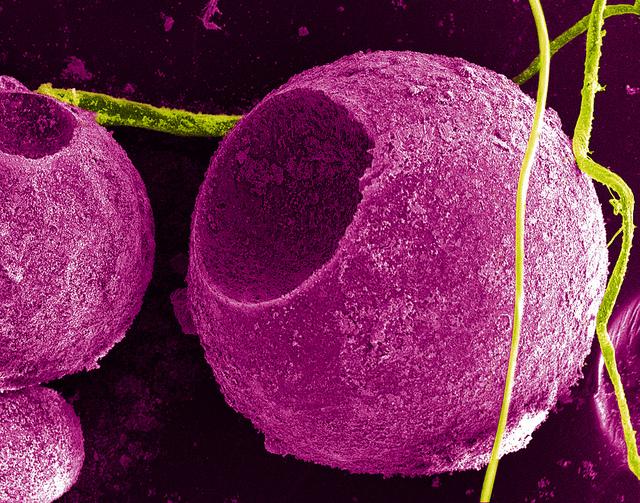 That's the approximate size of quantum dots—nanoparticles made of semiconducting materials that, when illuminated with light, produce a biochemical reaction in bacteria that re-establishes the power of antibiotics against multidrug-resistant (MDR) pathogens. A team of scientists from the University of Colorado Boulder describes their research in a paper today in Science Advances.
That's the approximate size of quantum dots—nanoparticles made of semiconducting materials that, when illuminated with light, produce a biochemical reaction in bacteria that re-establishes the power of antibiotics against multidrug-resistant (MDR) pathogens. A team of scientists from the University of Colorado Boulder describes their research in a paper today in Science Advances.
In a series of experiments, the team showed that the light-activated quantum dots, when combined with antibiotics, significantly reduced the levels of antibiotic resistance in a collection of multidrug-resistant clinical isolates, thereby enabling the antibiotics to kill the isolates at much lower concentrations than are normally necessary. In some cases, the amount of antibiotic required was 1,000 times lower. Synergy between the nanoparticles and antibiotics was also observed in cell and animal infection models, with no adverse effects.
"The strategy clearly works well against these superbugs," co-lead author Prashant Nagpal, PhD, an assistant professor of chemical and biological engineering at CU Boulder, said in an interview.
A 'one-two' punch
The strategy is a variation of an approach the team has been working on now for several years. In a paper published last year, they described how illuminated quantum dots could inhibit and kill highly drug-resistant bacteria through a targeted interaction with the cellular environment. While that research hinted at the potential of manufactured nanoparticles to be antibiotic alternatives, Nagpal and his colleagues also theorized that illuminated quantum dots could be used to re-potentiate antibiotics that have become ineffective against multidrug-resistant pathogens.
In the new study, the team demonstrates that when activated by an external source of light, the quantum dots produce a reactive oxygen species called superoxide within the bacterial cells. While superoxide and other reactive oxygen species are normally present in bacteria at low levels, at elevated levels they can overwhelm bacterial defenses and cause significant damage to bacterial DNA. The elevated levels of superoxide provoke the defenses of bacteria to gear up for battle.
That reaction, in turn, creates a diversion that weakens the bacteria's ability to fight the antibiotics, enabling smaller amounts of antibiotics to kill the bacteria. Nagpal calls it a "one-two punch." His co-lead author, Anushree Chatterjee, PhD, explains how it works.
"It's very interesting, because some of these superbugs have resistance genes…and despite these resistance genes, the antibiotic is getting potentiated," said Chatterjee, also a professor of chemical and biological engineering at CU Boulder. "What's happening is that we are kind of eating into the cellular resources dedicated to fighting these kinds of stresses, and we are overwhelming the bacterial system, and that's why they are getting sensitized."
In a series of in vitro experiments, the illuminated nanoparticles were able to increase the sensitivity of four different strains of MDR bacteria (including Escherichia coli, Salmonella enterica, and Klebsiella pneumoniae) to five different classes of antibiotics in more than 75% of the combinations tested. The approach also increased sensitivity to antibiotics in intestinal epithelial cells infected with Salmonella enterica, which demonstrated that it could work in difficult-to-treat intracellular infections. In an animal infection model, the synergistic combination helped improve survival in nematodes (roundworms) infected with Salmonella enteritidis. No adverse effects were observed.
The scientists say the observed synergistic interactions in these experiments highlights the ability of superoxide to increase the sensitivity of a range of bacteria to antibiotic therapy.
"These two work so synergistically and so beautifully in tandem, that it just knocks out and kills all of these really nasty pathogens and clinical strains," Nagpal said.
A platform for new therapies
Nagpal explained that visible light isn't the only form of stimuli that activates the quantum dots. They chose light because it's easy to demonstrate. But illuminated quantum dots could be a good approach for skin and burn infections. He said they're also investigating quantum dots that respond to near-infrared light and sound waves, which could enable to the strategy to be used on deeper tissue and bone infections. When the quantum dots aren't being activated by stimuli, they don't produce any superoxide and have no effect on the bacteria.
Although clinical use of quantum dots for drug-resistant infections is a long way off, the strategy is an intriguing new approach at a time when the pipeline for new antibiotics is broken and novel methods of fighting antibiotic resistance are urgently needed. "This is very different from a small molecule approach, which has a very specific kind of target," Chatterjee said. "Here, we are targeting a process."
Nagpal and Chatterjee say the team will continue to pursue various methods of using quantum dot technology to fight drug-resistant bacteria, and hope to ultimately develop a whole cocktail of quantum dot-based therapeutics.
"We are not just developing this as a one-off therapy," said Nagpal. "We are thinking several steps ahead."


